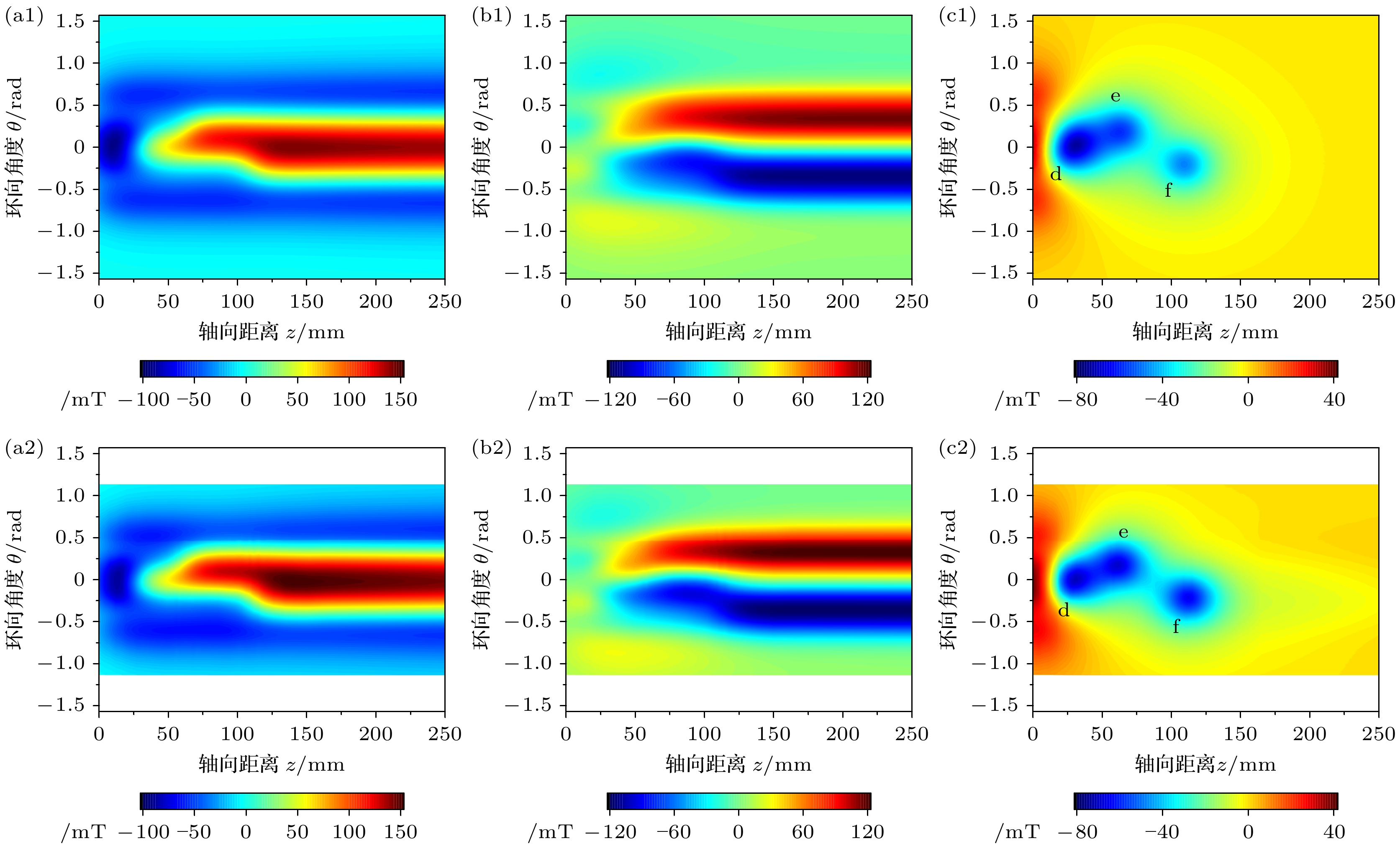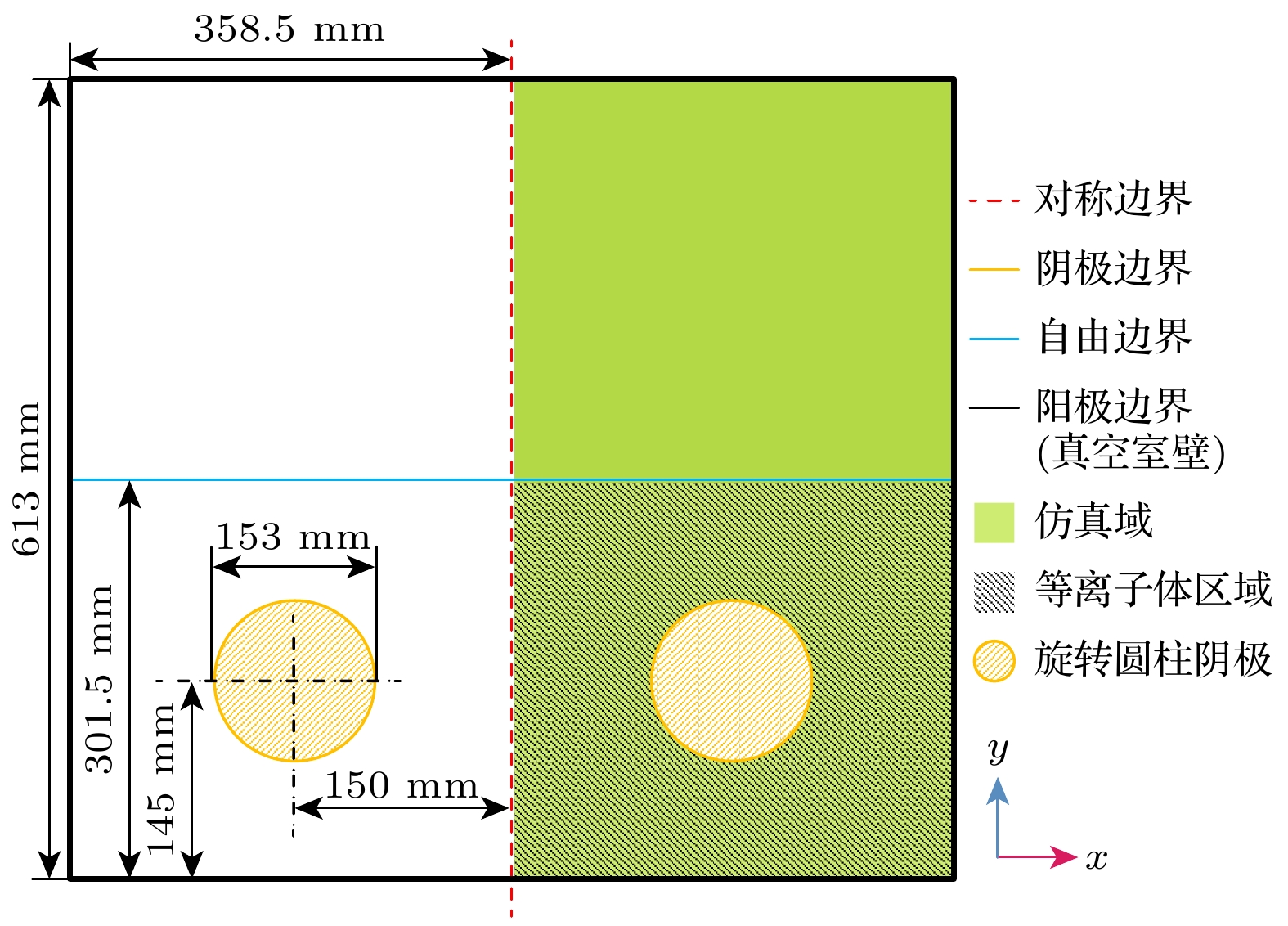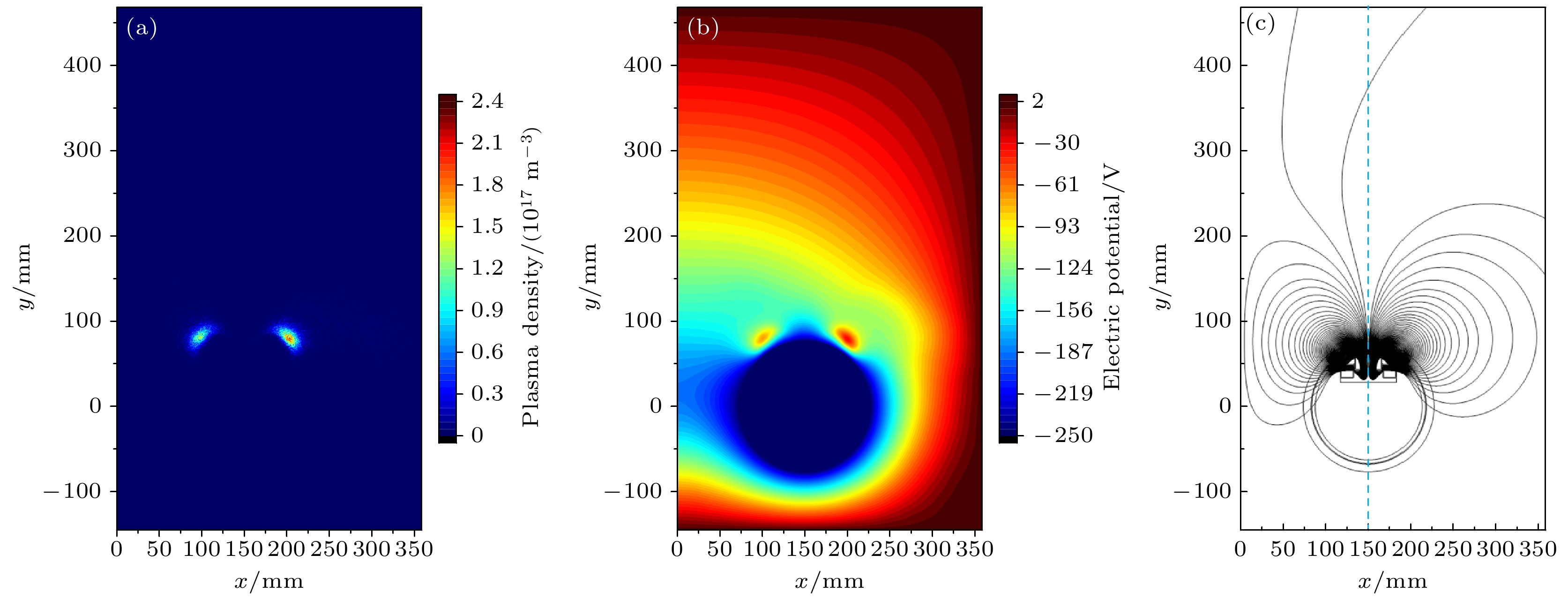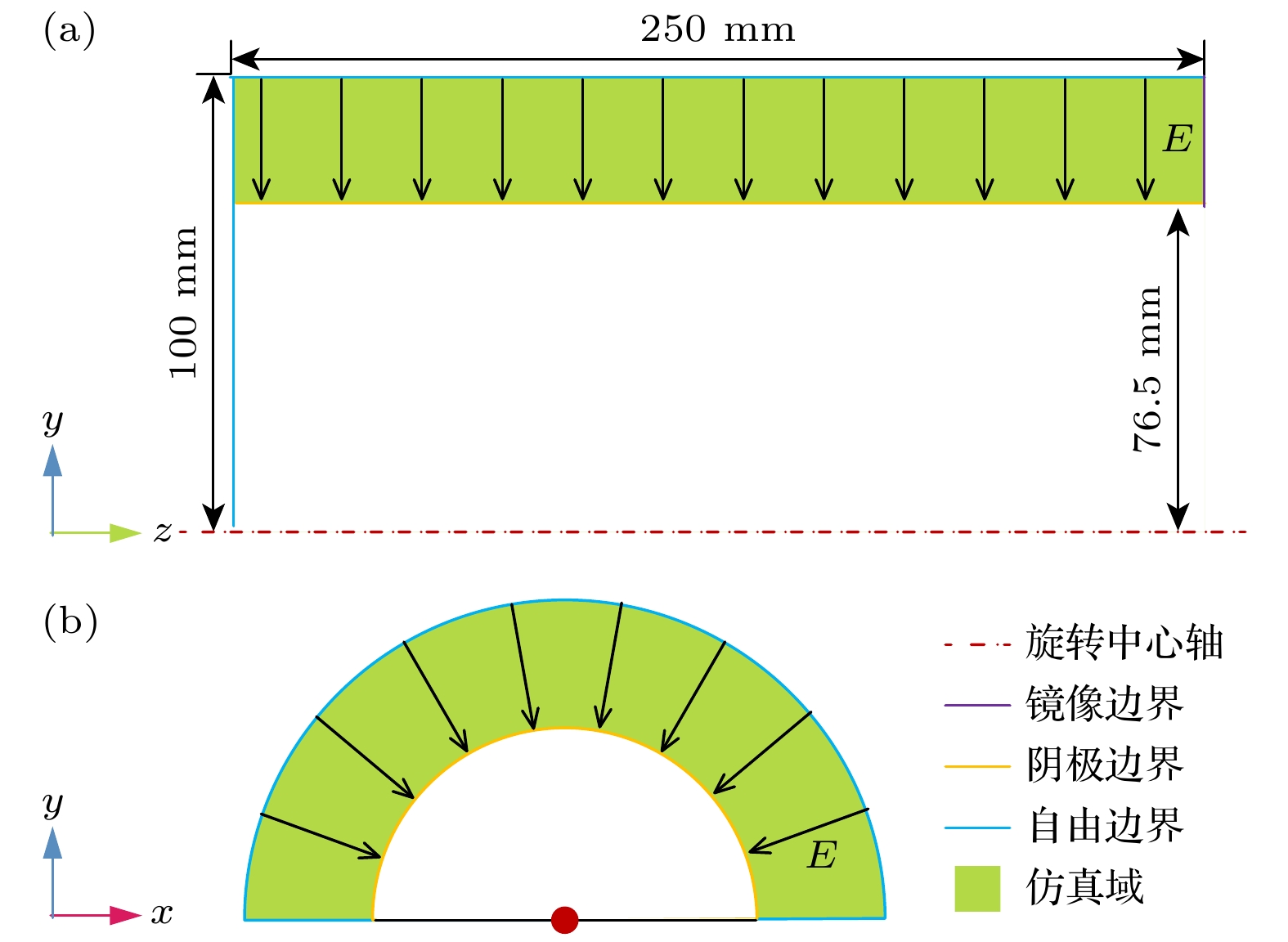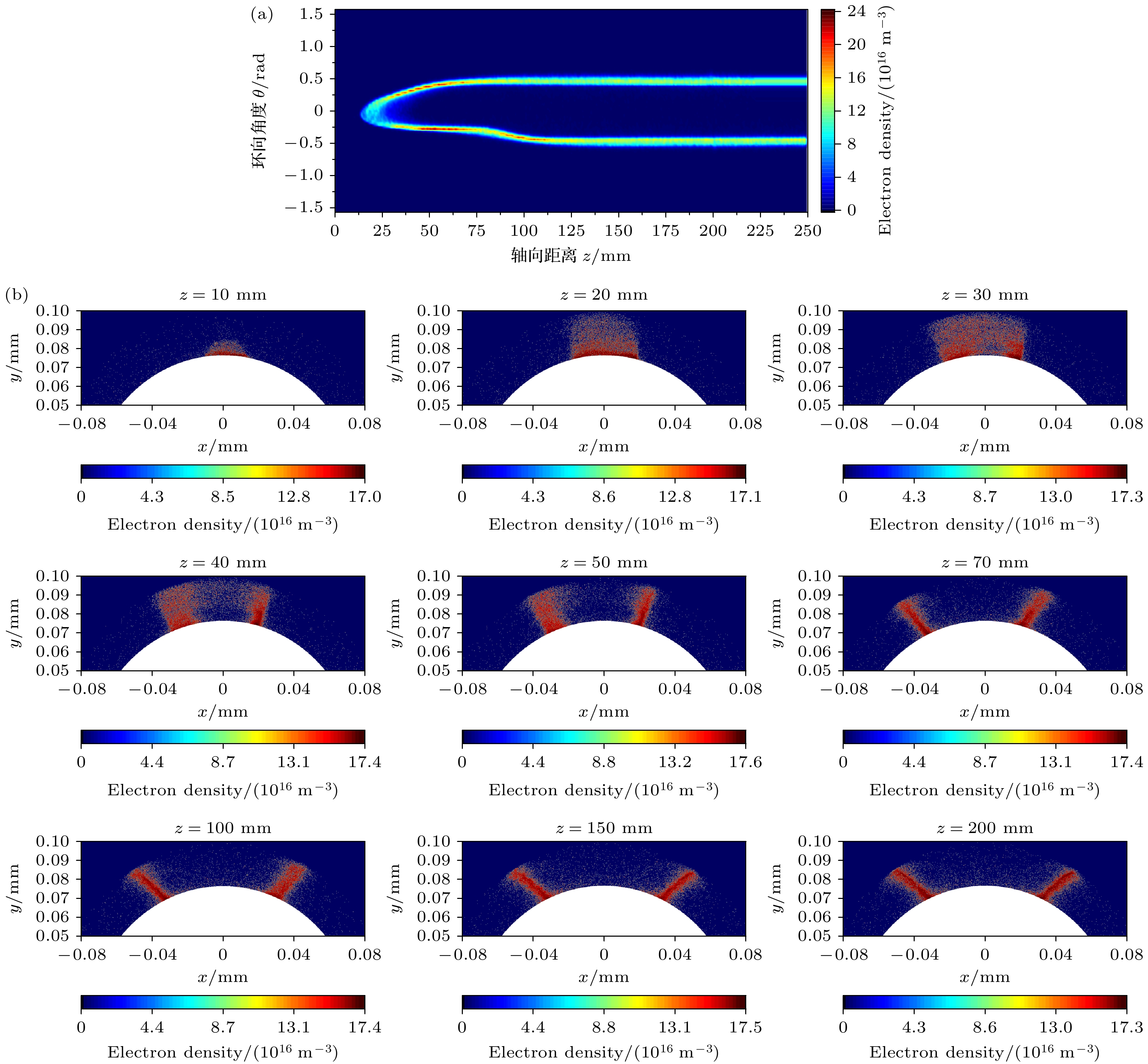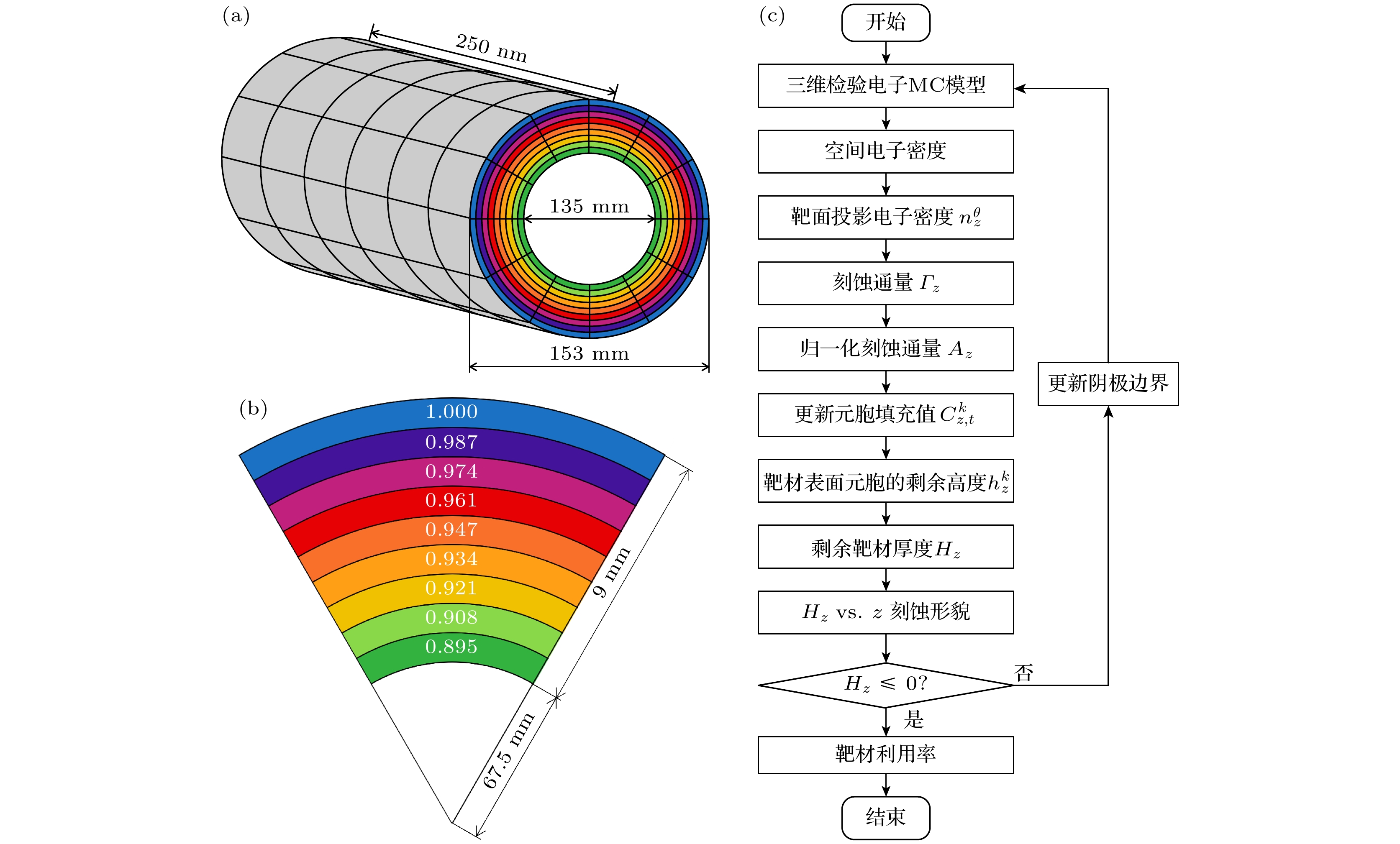-
Rotating cylindrical cathodes possess high theoretical target utilization rates and have been widely used in thin film deposition in various industries. Regarding plasma research, the plasma discharge and transport processes of rotating cylindrical cathodes involve three-dimensional systems, unlike those of planar cathodes. Traditional plasma models applied to these systems require a large quantity of computational resources and have poor convergence, making simulation difficult. In this context, the plasma density and electric potential distributions are calculated by a two-dimensional particle-in-cell/Monte Carlo collision (PIC/MCC) model, and they are used as a self-consistent background field in this work. Furthermore, a three-dimensional electron Monte Carlo method is used to track electron motion, so that three-dimensional plasma discharge simulation can be performed. On this basis, using plasma density projection as the etching flux and the cellular automata method, the rotational etching process of the cylindrical cathode is decomposed into stepwise micro-element static etching, thereby achieving three-dimensional etching behavior simulation. Subsequently, the etched target morphology is equivalently treated as the emission flux of In and Sn atoms, and a three-dimensional test particle Monte Carlo method is employed to trace their motion, realizing three-dimensional particle deposition simulation. Thus, a comprehensive three-dimensional simulation system is constructed through incorporating the cathode magnetic field, plasma discharge, target etching, and thin-film deposition into a complete simulation chain. The results indicate that this three-dimensional simulation system can accurately predict the operating conditions of cylindrical cathodes. The plasma stably accumulates on the cylindrical cathode surface, forming a three-dimensional discharge race track. The simulated etching profile is consistent with experimental result, showing the precise matching of the feature points with the residual thickness of the target. The utilization rate of the target material is 85.81%, with an error of less than 2% compared with that of the measurement. The molar ratio of In/Sn on the substrate is 11.76, with an error of 6.6% compared with the results measured by energy dispersive spectroscopy. The particle distribution on the substrate matches the actual film thickness distribution, with a uniform deposition length of 1730 mm, representing an error of only 1.1% compared with corresponding actual value.
-
Keywords:
- rotating cylindrical magnetron /
- three-dimensional modeling /
- plasma discharge /
- plasma transport
[1] Saenko A V, Tominov R V, Jityaev I L, Vakulov Z E, Avilov V I, Polupanov N V, Smirnov V A 2024 Nanomaterials 14 1901
 Google Scholar
Google Scholar
[2] Dhage S R, Badgujar A C 2018 J. Alloys Compd. 763 504
 Google Scholar
Google Scholar
[3] Chen J F, Ding X P, Wang J F, Xie Z Y, Wang S H 2024 J. Alloys Compd. 1002 175318
 Google Scholar
Google Scholar
[4] Sarakinos K, Alami J, Konstantinidis S 2010 Surf. Coat. Technol. 204 1661
 Google Scholar
Google Scholar
[5] Matthews S, De Bosscher W, Blondeel A, Van Holsbeke J, Delrue H 2008 Vacuum 83 518
 Google Scholar
Google Scholar
[6] Park J H, Ahn K J, Na S I, Kim H K 2011 Sol. Energy Mater. Sol. Cells 95 657
 Google Scholar
Google Scholar
[7] Park J H, Ahn K J, Park K I, Na S I, Kim H K 2010 J. Phys. D: Appl. Phys. 43 115101
 Google Scholar
Google Scholar
[8] Van Aeken K, Maheude S, Depla D 2008 J. Phys. D: Appl. Phys. 41 205307
 Google Scholar
Google Scholar
[9] Fan Q H, Grago J J, Zhou L Q 2004 J. Appl. Phys. 95 6017
 Google Scholar
Google Scholar
[10] Teunissen J, Ebert U 2016 Plasma Sources Sci. Technol. 25 044005
 Google Scholar
Google Scholar
[11] Bogaerts A, Bultinck E, Kolev I, Schwaederlé L, Van Aeken K, Buyle G, Depla D 2009 J. Phys. D: Appl. Phys. 42 194018
 Google Scholar
Google Scholar
[12] Musschoot J, Depla D, Buyle G, Haemers J, De Gryse R 2006 J. Phys. D: Appl. Phys. 39 3989
 Google Scholar
Google Scholar
[13] Fu Y, Ji P, He M, Huang P, Huang G, Huang W 2024 Plasma Chem. Plasma Process. 44 601
 Google Scholar
Google Scholar
[14] Bogaerts A, Kolev I, Buyle G 2008 Modeling of the Magnetron Discharge (Berlin: Springer) pp61–130
[15] Zhu G, Yang Y, Xiao B, Gan Z 2023 Molecules 28 7660
 Google Scholar
Google Scholar
[16] 崔岁寒, 左伟, 黄健, 李熙腾, 陈秋皓, 郭宇翔, 杨超, 吴忠灿, 马正永, 傅劲裕, 田修波, 朱剑豪, 吴忠振 2023 物理学报 72 085202
 Google Scholar
Google Scholar
Cui S H, Zuo W, Huang J, Li X T, Chen Q H, Guo Y X, Yang C, Wu Z C, Ma Z Y, Fu J Y, Tian X B, Zhu J H, Wu Z Z 2023 Acta Phys. Sin. 72 085202
 Google Scholar
Google Scholar
[17] Kapran A, Ballage C, Hubicka Z, Minea T 2025 Vaccum 238 114324
 Google Scholar
Google Scholar
[18] Sabavath G K, Swaroop R, Singh J, Panda A B, Haldar S, Rao N, Mahapatra S K 2022 Plasma Phys. Rep. 48 548
 Google Scholar
Google Scholar
[19] Cui S H, Chen Q H, Guo Y X, Chen L, Jin Z, Li X T, Yang C, Wu Z C, Su X Y, Ma Z Y, Fu R K Y, Tian X B, Chu P K, Chu W Z 2022 J. Phys. D: Appl. Phys. 55 325203
 Google Scholar
Google Scholar
[20] Sirghi L, Aoki T, Hatanaka Y 2004 Surf. Coat. Technol. 187 358
 Google Scholar
Google Scholar
[21] Bultinck E, Kolev I, Bogaerts A, Depla D 2008 J. Appl. Phys. 103 013309
 Google Scholar
Google Scholar
[22] Cui S H, Wu Z Z, Lin H, Xiao S, Zheng B C, Liu L L, An X K, Fu R K Y, Tian X B, Tan W C, Chu P K 2019 J. Appl. Phys. 125 063302
 Google Scholar
Google Scholar
[23] Lennon M A, Bell K L, Gilbody H B, Hughes J G, Kingston A E, Murray M J, Smith F J 1988 J. Phys. Chem. Ref. Data 17 1285
 Google Scholar
Google Scholar
[24] 沈向前, 谢泉, 肖清泉, 陈茜, 丰云 2012 物理学报 61 165101
 Google Scholar
Google Scholar
Shen X Q, Xie Q, Xiao Q Q, Chen Q, Feng Y 2012 Acta Phys. Sin. 61 165101
 Google Scholar
Google Scholar
[25] Chen L, Cui S H, Tang W, Zhou L, Li T, Liu L, An X, Wu Z, Ma Z, Lin H 2020 Plasma Sources Sci. Technol. 29 025016
 Google Scholar
Google Scholar
[26] Nanbu K, Konodo S 1997 Jpn. J. Appl. Phys. 36 4808
 Google Scholar
Google Scholar
[27] Shidoji E, Nemoto M, Nomura T 2000 J. Vac. Sci. Technol. A 18 2858
 Google Scholar
Google Scholar
[28] Mikolaychuk M, Knyazeva A 2014 AIP Conf. Proc. 1623 419
 Google Scholar
Google Scholar
[29] Liu H, Niu X, Yu D R 2019 J. Plasma Phys. 85 905850208
 Google Scholar
Google Scholar
[30] Rumble J R 2024 CRC Handbook of Chemistry and Physics (Florida: CRC Press) pp10–113
[31] Shon C H, Lee J K 2002 Appl. Surf. Sci. 192 258
 Google Scholar
Google Scholar
-
图 1 ITO圆柱阴极的基本结构与磁场配置 (a) 三维模型; (b) 横截面图; (c) 磁铁配置俯视图, 其中蓝色矢量符号表示磁极方向; (d) 端头和(e) 直部的磁铁配置截面
Figure 1. Basic structure and magnetic field configuration of ITO cylindrical cathode: (a) Three-dimensional (3D) model; (b) cross-sectional view; (c) top view of the magnet configuration, where the blue vectors represent the direction of the magnetic poles; (d), (e) magnet configuration of (d) the end and (e) the straight section.
图 2 圆柱靶材表面各向磁场分布 (a1)仿真和(a2)实验的法向(r)磁感应强度; (b1)仿真和(b2)实验的环向(θ)磁感应强度; (c1)仿真和(c2)实验的轴向(z)磁感应强度
Figure 2. Distribution of magnetic field on the surface of the cylindrical target: (a1), (a2) Normal (r) magnetic flux density by (a1) simulation and (a2) experiment; (b1), (b2) azimuthal (θ) magnetic flux density by (b1) simulation and (b2) experiment; (c1), (c2) axial (z) magnetic flux density by (c1) simulation and (c2) experiment.
序号 反应方程式 反应速率系数 k r/(m3⋅s–1) 反应阈值/eV 反应类型 1 e+Ar → Ar+e $ 2.336 \times {10^{ - 14}}{T_{\text{e}}}^{1.609} \exp \left[ {0.0618{{\left( {\ln {T_{\text{e}}}} \right)}^2} - 0.1171{{\left( {\ln {T_{\text{e}}}} \right)}^3}} \right] $ — 弹性碰撞 2 e+Ar → Ar++2e $ 2.34 \times {10^{ - 14}}{T_{\text{e}}}^{0.59} \times \exp \left( { - 17.44/{T_{\text{e}}}} \right) $ 15.76 电离碰撞 3 e+Ar → Arm+e $ 2.5 \times {10^{ - 15}}{T_{\text{e}}}^{0.74} \times \exp \left( { - 11.56/{T_{\text{e}}}} \right) $ 11.56 激发碰撞 4 e+Arm → Ar++2e $ 6.8 \times {10^{ - 15}}{T_{\text{e}}}^{0.67} \times \exp \left( { - 4.2/{T_{\text{e}}}} \right) $ 4.2 激发态电离 5 e+Arm → Ar+e $ 4.3 \times {10^{ - 16}}{T_{\text{e}}}^{0.74} $ –11.56 退激发碰撞 6 Ar++Ar → Ar++Ar 硬球碰撞 — 弹性碰撞 7 Ar++Ar → Ar+Ar+ 硬球碰撞 — 电荷交换 -
[1] Saenko A V, Tominov R V, Jityaev I L, Vakulov Z E, Avilov V I, Polupanov N V, Smirnov V A 2024 Nanomaterials 14 1901
 Google Scholar
Google Scholar
[2] Dhage S R, Badgujar A C 2018 J. Alloys Compd. 763 504
 Google Scholar
Google Scholar
[3] Chen J F, Ding X P, Wang J F, Xie Z Y, Wang S H 2024 J. Alloys Compd. 1002 175318
 Google Scholar
Google Scholar
[4] Sarakinos K, Alami J, Konstantinidis S 2010 Surf. Coat. Technol. 204 1661
 Google Scholar
Google Scholar
[5] Matthews S, De Bosscher W, Blondeel A, Van Holsbeke J, Delrue H 2008 Vacuum 83 518
 Google Scholar
Google Scholar
[6] Park J H, Ahn K J, Na S I, Kim H K 2011 Sol. Energy Mater. Sol. Cells 95 657
 Google Scholar
Google Scholar
[7] Park J H, Ahn K J, Park K I, Na S I, Kim H K 2010 J. Phys. D: Appl. Phys. 43 115101
 Google Scholar
Google Scholar
[8] Van Aeken K, Maheude S, Depla D 2008 J. Phys. D: Appl. Phys. 41 205307
 Google Scholar
Google Scholar
[9] Fan Q H, Grago J J, Zhou L Q 2004 J. Appl. Phys. 95 6017
 Google Scholar
Google Scholar
[10] Teunissen J, Ebert U 2016 Plasma Sources Sci. Technol. 25 044005
 Google Scholar
Google Scholar
[11] Bogaerts A, Bultinck E, Kolev I, Schwaederlé L, Van Aeken K, Buyle G, Depla D 2009 J. Phys. D: Appl. Phys. 42 194018
 Google Scholar
Google Scholar
[12] Musschoot J, Depla D, Buyle G, Haemers J, De Gryse R 2006 J. Phys. D: Appl. Phys. 39 3989
 Google Scholar
Google Scholar
[13] Fu Y, Ji P, He M, Huang P, Huang G, Huang W 2024 Plasma Chem. Plasma Process. 44 601
 Google Scholar
Google Scholar
[14] Bogaerts A, Kolev I, Buyle G 2008 Modeling of the Magnetron Discharge (Berlin: Springer) pp61–130
[15] Zhu G, Yang Y, Xiao B, Gan Z 2023 Molecules 28 7660
 Google Scholar
Google Scholar
[16] 崔岁寒, 左伟, 黄健, 李熙腾, 陈秋皓, 郭宇翔, 杨超, 吴忠灿, 马正永, 傅劲裕, 田修波, 朱剑豪, 吴忠振 2023 物理学报 72 085202
 Google Scholar
Google Scholar
Cui S H, Zuo W, Huang J, Li X T, Chen Q H, Guo Y X, Yang C, Wu Z C, Ma Z Y, Fu J Y, Tian X B, Zhu J H, Wu Z Z 2023 Acta Phys. Sin. 72 085202
 Google Scholar
Google Scholar
[17] Kapran A, Ballage C, Hubicka Z, Minea T 2025 Vaccum 238 114324
 Google Scholar
Google Scholar
[18] Sabavath G K, Swaroop R, Singh J, Panda A B, Haldar S, Rao N, Mahapatra S K 2022 Plasma Phys. Rep. 48 548
 Google Scholar
Google Scholar
[19] Cui S H, Chen Q H, Guo Y X, Chen L, Jin Z, Li X T, Yang C, Wu Z C, Su X Y, Ma Z Y, Fu R K Y, Tian X B, Chu P K, Chu W Z 2022 J. Phys. D: Appl. Phys. 55 325203
 Google Scholar
Google Scholar
[20] Sirghi L, Aoki T, Hatanaka Y 2004 Surf. Coat. Technol. 187 358
 Google Scholar
Google Scholar
[21] Bultinck E, Kolev I, Bogaerts A, Depla D 2008 J. Appl. Phys. 103 013309
 Google Scholar
Google Scholar
[22] Cui S H, Wu Z Z, Lin H, Xiao S, Zheng B C, Liu L L, An X K, Fu R K Y, Tian X B, Tan W C, Chu P K 2019 J. Appl. Phys. 125 063302
 Google Scholar
Google Scholar
[23] Lennon M A, Bell K L, Gilbody H B, Hughes J G, Kingston A E, Murray M J, Smith F J 1988 J. Phys. Chem. Ref. Data 17 1285
 Google Scholar
Google Scholar
[24] 沈向前, 谢泉, 肖清泉, 陈茜, 丰云 2012 物理学报 61 165101
 Google Scholar
Google Scholar
Shen X Q, Xie Q, Xiao Q Q, Chen Q, Feng Y 2012 Acta Phys. Sin. 61 165101
 Google Scholar
Google Scholar
[25] Chen L, Cui S H, Tang W, Zhou L, Li T, Liu L, An X, Wu Z, Ma Z, Lin H 2020 Plasma Sources Sci. Technol. 29 025016
 Google Scholar
Google Scholar
[26] Nanbu K, Konodo S 1997 Jpn. J. Appl. Phys. 36 4808
 Google Scholar
Google Scholar
[27] Shidoji E, Nemoto M, Nomura T 2000 J. Vac. Sci. Technol. A 18 2858
 Google Scholar
Google Scholar
[28] Mikolaychuk M, Knyazeva A 2014 AIP Conf. Proc. 1623 419
 Google Scholar
Google Scholar
[29] Liu H, Niu X, Yu D R 2019 J. Plasma Phys. 85 905850208
 Google Scholar
Google Scholar
[30] Rumble J R 2024 CRC Handbook of Chemistry and Physics (Florida: CRC Press) pp10–113
[31] Shon C H, Lee J K 2002 Appl. Surf. Sci. 192 258
 Google Scholar
Google Scholar
Catalog
Metrics
- Abstract views: 2018
- PDF Downloads: 58
- Cited By: 0














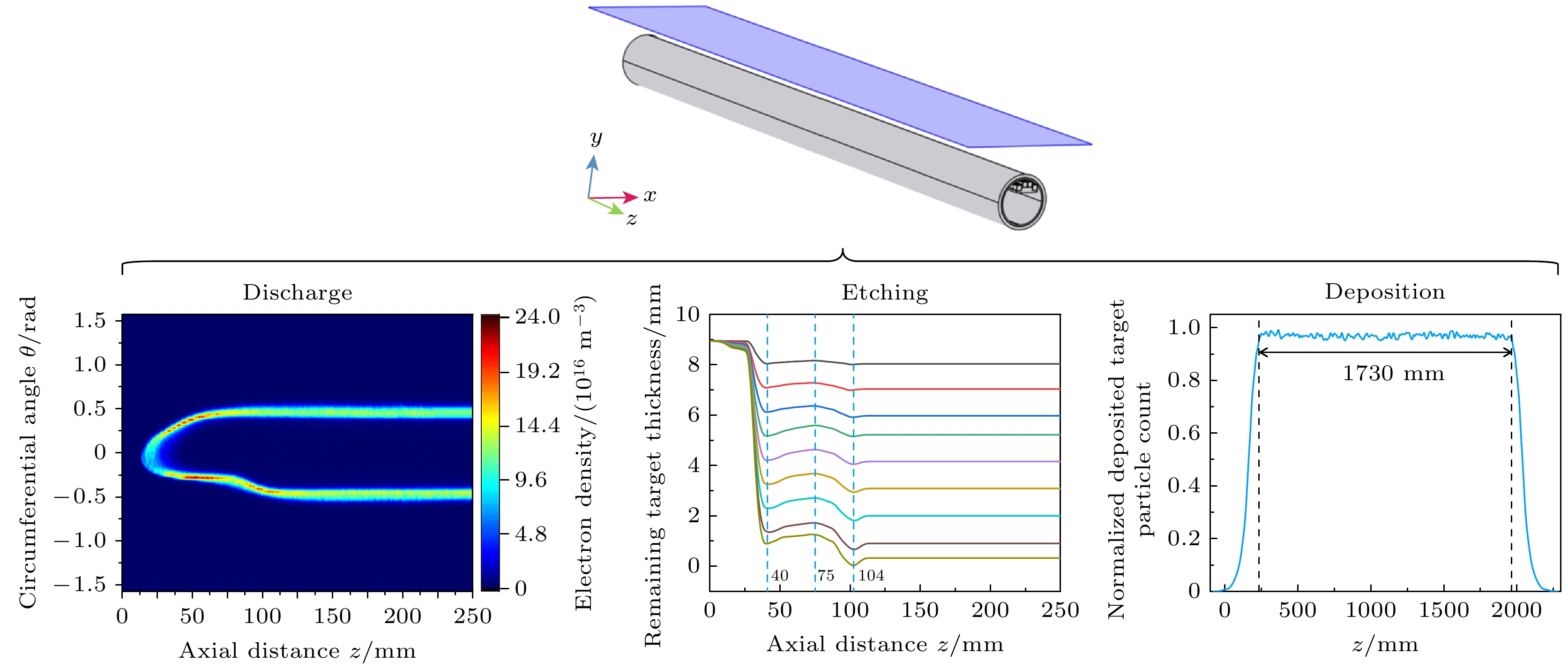
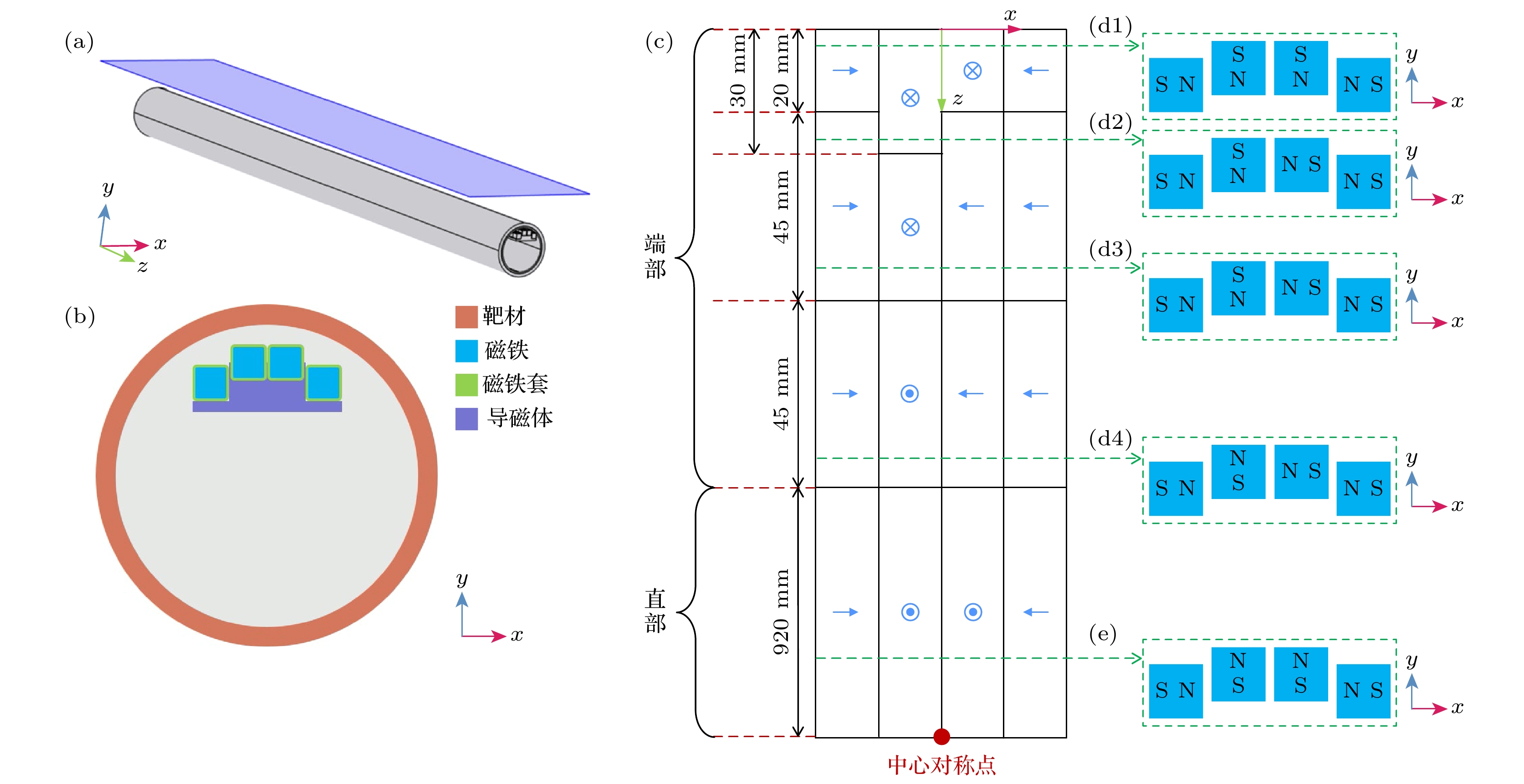
 DownLoad:
DownLoad:
